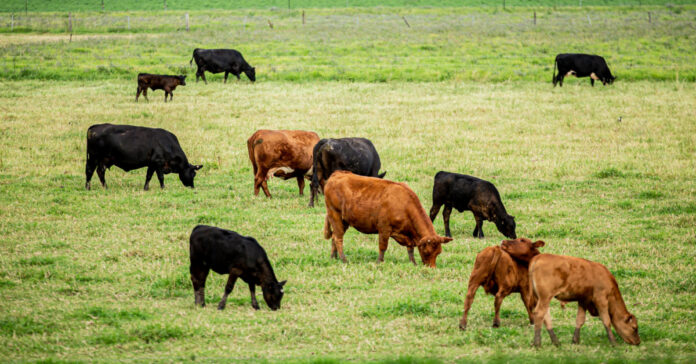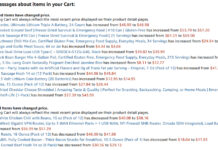I had an interesting discussion with a friend who leases most of his land to a farmer. The farmer runs beef cattle on it and maintains the fencing and watering infrastructure. My friend reported that the farmer is selling all his old equipment on the used market and buying brand new equipment, including his tractor and trucks.
Why? Because the farmer believes that anything that breaks down and has to be replaced in the next few years will be far more expensive to buy in the future than it costs today. Yes, this cattle rancher is expecting inflation. Massive inflation.
By buying new hardware and equipment today, he figures he is buying a ten-year window of minimal service and repairs while getting top-dollar for his used gear. I wonder if he is stocking up on barbed wire, veterinary medicines, salt blocks and other farming necessities, or if he’s building any new buildings?
He’s preparing for the future in a way most of us preppers don’t. Because he’s self-employed, he’s taking steps that many of us cannot. That’s a smart approach.
I think buying new trucks and tractors makes a great deal of sense. Building materials, however, may drop in price next year. Or maybe not. I bought 2x4s yesterday and the price is now above $10 for an 8-foot board. That’s up $2 since I bought them in March.
Thinking Big
In the past, I’ve talked about stocking up on consumables and tangibles to fight inflation; things like food, ammo, guns and accessories. In our article All About Inflation and How to Protect Yourself, I recommended buying a good pickup truck, farmland, investing in livestock, and investing in yourself via training and education. Sounds like this farmer is thinking right along the same lines. In fact, he’s a few steps ahead of me.
That earlier article discussed what “Mark” a fictitious character, should do with $20,000 in savings. Sounds like this farmer probably spent ten times that. (Tractors are expensive.)
So, what should you do if instead of $20,000, you had a couple hundred thousand or even a few million dollars and wanted to protect it from inflation? Here are my suggestions
Buy Property
My number one piece of advice is to buy income-producing property that you can rent to provide income and then sell after inflation cools down (assuming it does) or we have some sort of recovery.
If you don’t want to be a landlord, my second-best advice is to buy farmland (yes, I am reprising this one). You don’t have to farm it. You can lease it to someone who does. Keep leases short so you can adjust the cost upwards as prices rise or build in some kind of escalation clause based on the CPI. (The CPI will continue to under-report inflation, but it’s better than nothing.)
I recommend pasture land. It’s flexible, low maintenance, and in a worst-case scenario, you could use it to follow Joel Salatin’s proven methods of turning pasture into very productive farmland. Joel Salatin has probably single-handedly caused a revolution in small-scale pasture farming. There are dozens of videos about him. In the one below, he discusses the techniques he uses to make pasture four-times more productive for cattle than it is on traditional farms.
Reconfigure Your Investments
My third-ranked advice would be to revamp your paper investments. Some equities can hold their own in periods of inflation; they should out-perform fixed income investments. I’d consider investing in companies that are vertically integrated or who are close to the production of the raw materials rather than the finished product. These producers will be buffeted less by the escalating costs.
I’d also set aside a chunk of savings and split it between silver, gold and Ethereum or Bitcoin. I am no investment advisor, but I think I would go with 40 to 50 percent in gold as wealth preservation, 30 to 40 percent in silver in case I needed spending money, as 10 to 20 percent in Ether and BTC. Just be sure to take physical delivery of a chunk of the precious metals. It doesn’t do you much good sitting in a vault in New York or Switzerland if the system collapses.
When Cash is Not King
Dave Ramsey, who I credit for helping people get out of debt and on sounder financial footing, likes to say that cash is king. Hard to argue with that, most of the time. The exception to that rule is in times of high inflation.
During periods of inflation, hanging on to your cash is a mistake. As we saw with made-up-Mark, the money he kept in his money market account bought less and less each year. Once inflation hits and the rate rises above six percent, I think you are better off spending it than saving it. If you can’t figure out what to buy, then add to your positions in the paper investments I mentioned earlier.

How to Handle Debt During Inflation
Although I agree that debt is best avoided, if you can buy a car or truck at or close to a zero percent interest rate, then do it. Assuming your income rises with inflation, you will pay for that car over the next five years with money that is worth less and less, at no real cost to you. If we were to see Argentina-like inflation (40 percent in 2020, down from 54 percent in 2019), your car would cost you less than half its original price in two years.
I expect we will see interest rates rise as inflation makes inroads. If you borrow, avoid floating or adjustable rates. When you buy a home, get a fixed rate mortgage. If you insist on an adjustable rate mortgage, make sure the rate does not adjust for at least five to seven years and has a ceiling or maximum upward adjustment you can live with.
If you are in business and write contracts to cover future sales, tie the price to the cost of a key ingredient. For example, if you make polystyrene foam cups, charge your customer a price that goes up based on the cost of polystyrene on the day of shipment.
Inflation Spirals Up
Imagine that I manufacture and sell widgets wholesale for $20. The raw materials cost me $10. By the time I pay my rent, electric, employees, insurance, and other costs associated with running business, I end up making $1 per widget before taxes.
Due to the rising cost of commodities, my raw material costs go up $2. If all my other costs stay the same, I am now losing $1 per widget. I could raise my prices $2, keeping my $1 profit per widget. However, because I expect prices to keep rising and don’t want to lose money on widgets in the future, I raise the price $4 per widget, which is the same 20 percent that my raw materials went up. My customer, who buy my widgets for $20 and sell them retail for $30 to $40, must now absorb the $4 cost increase. Most of them can’t, so they increase their sales price by 20 percent, or between $6 and $8.
This is how a $2 raw materials increase becomes a $6 or $8 price increase to the consumer.
Because prices are rising, my employees grouse. It becomes clear that I need to hand out some raises to stay competitive. Most of my employees make between $13 and $18 an hour. I give raises between $1.50 and $2 per hour, about 11 percent.
The employees are pretty happy because 11 percent raises are unheard of. They don’t realize that the cost of many goods have gone up 20 percent. Their new, bigger paycheck doesn’t last long. Soon, I’m giving out raises every six months. As inflation rises faster and faster, it may force us to giving raises every quarter or even every month.
This is an example of how employees fall behind during periods of high inflation.
Inflation Creates Poverty
When the upward spiral of costs speeds up, like we see in the example above, government programs cannot keep up. They cannot raise the rates for programs like social security and SNAP every quarter and remain are stuck on a one-year schedule. As the year progresses, their government check covers less and less. Even when the increase comes through, it’s not enough.
Isn’t it funny how the liberals who want to “do something” about poverty are creating the programs that will cause inflation to rise, make the poor even worse off, and push more of the middle class into poverty?
Let’s revisit the widget business. As the cost of widgets rise to between $50 and $60, people decide they don’t need widgets. When it comes to putting food on the table or buying a widget, they choose the food. Widget sales drop, which causes a portion of the work force to be let go. Since less raw materials are being consumed, there’s less work for the guys producing the raw materials and the truck drivers making deliveries to the plant. As sales drop, there’s less work at the retailers and fewer packages for the UPS and Fedex drivers who deliver to our retailers. Imagine this in a large scale for millions of products, and you can see why inflation has brought on a recession.
Prepare Yourself
I think it’s important to remind ourselves that this country experienced a spate of inflation in the late 1970s and early 1980s and survived. That doesn’t mean you shouldn’t prepare yourself for the unexpected, just that it doesn’t have to last forever.
Whether its simple steps like adjusting your retirement investments and preparing for a recession or a more complicated step like buying property or moving, don’t wait. While the Fed things inflation will be “transitory,” I think it is likely to last several years. Get prepared now.







